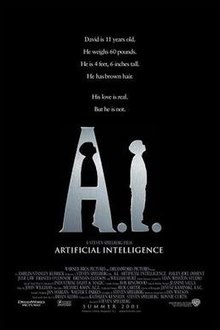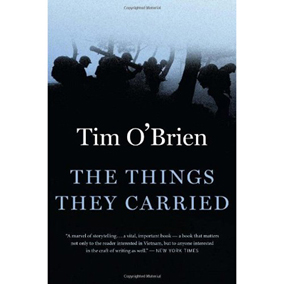In Mary Shelley's Frankenstein, one of the central themes is the idea that science can lead to harmful results. This is presented through the hypothetical production of a being much more intelligent and much closer to human than the creator expected. This 'creature' (referred to as Pedro for brevity) attempts to understand the world, but is often misunderstood, even by his own creator.
(But we've talked about this in class, so I'll try not to reiterate our discussions.)
This situation reminded me of a similar type of symbolic narrative in sci-fi.
Some of you may be familiar with the movie A.I.; if you're not, I'd recommend skimming [[the story on which it is based]] or at least [[a synopsis]]. (And even if you are, the story is worth checking out!)
To review, the movie's premise is fairly simple: a couple's child goes into a coma as the result of a rare disease, and after much soul-searching, they decide to adopt a prototype 'imprinting' AI, which is programmed to feel emotion in much the same way as a human. This boy, David, lives happily with his 'mother', Monica, and 'father', Henry, until their real son, Martin, is cured; after various conflicts, he is abandoned by his family because Monica can't bring herself to send him to be dismantled.
From this point in the movie, he experiences many forms of discrimination; he is threatened with destruction at an anti-robot Flesh Fair, for instance. He attempts to find the 'Blue Fairy', inspired by the story of Pinocchio, in order to become a real boy. However-- (plot twist!)-- he ends up being buried deep in the ocean for several thousand years.
He is revived by highly advanced automatons after the human race has died out. In an attempt to discover more about the race that created their precursors, these robots ask him various questions and observe his interactions with a revived Monica; unfortunately, their technology can only revive humans for one day. The end of the movie sees David and the clone going to sleep, or, as David puts it, "that place where dreams are born."
Aside from the entire movie's tear-jerking attributes, there is quite a bit of deeper meaning.
I immediately saw several parallels to Frankenstein. Like Pedro, David is much more advanced and human than his creators might have expected-- indeed, even the robots without the emotional programming are portrayed as more caring and 'human' than the majority of humans. Both David and Pedro are abandoned by their creators and face persecution because of their lack of knowledge about the world. The audience sympathizes much more with David than with his creators, and I have to admit I'm becoming more sympathetic towards Pedro.
The purpose of both stories also appears to be cautionary. The eerily-human creations show that we have to be prepared to take responsibility for our explorations. Bioethics and roboethics are emerging fields, and professional advice often urges careful and slow development in ethically-dubious research.
I think these messages are important to consider, no matter what you think about research and development in artificial intelligence or other controversial fields. Interestingly enough, we are already seeing parallels to parts of these stories in the real world.
Friday, November 22, 2013
Friday, November 15, 2013
Cyberpunk and Postmodernism
On Thursday, we watched the play And They Dance Real Slow in Jackson. In case you didn't attend the play, I'll write a quick summary.
The main character, Elizabeth Ann Willow, suffers from polio and is effectively an outcast in her small Southern town. While she is good-natured and constantly attempts to connect with others, she is continually rebuffed and discussed behind her back. When she asks Skeeter to prom, for instance, he rejects her despite appearing to like her. Soon after, she goes down to the river and is attacked by a mob of frightened children who have convinced each other that she can take off her leg braces ("metal legs") and send them walking. This results in a complete withdrawal into her mind.
One of the most interesting features of the play was the way that information about what happened to Elizabeth was slowly revealed. Based on several perspectives (Elizabeth as a 24-year-old, trapped inside her head; Elizabeth as an 18-year-old; and the townspeople, observing her condition at 24 years old), the audience is able to slowly understand the full scope of the story. This reminded me considerably of something that we read last year.
The Things They Carried also jumped around a lot, changed narrators, and used surreal storytelling techniques. The overall impressions I received from the two works were similar; confusion was the first response, followed by gradual comprehension and an abrupt ending. Similar techniques were used in other books I've read, like Cloud Atlas and If on a winter's night a traveler; these I've discussed previously, so I won't waste space reiterating my points. However, I haven't discussed Neuromancer.
If you're not familiar with the novel, it's a disjoint account of a hacker's attempts to crack a highly-developed AI. The setting is quite foggy, and few details are given, contributing to a sense of unreality; the narration is also disorienting, and makes less and less sense as the plot progresses. However, by the end of the book, a good number of the hanging ends have been resolved, and even without understanding exactly what has happened, a reader can feel a sense of completion.
Still, I didn't deeply enjoy any of the above works. Perhaps it's an effective use of reader response theory-- but I can't say this kind of manipulation of confusion particularly appeals to me as a reader.
One of the most interesting features of the play was the way that information about what happened to Elizabeth was slowly revealed. Based on several perspectives (Elizabeth as a 24-year-old, trapped inside her head; Elizabeth as an 18-year-old; and the townspeople, observing her condition at 24 years old), the audience is able to slowly understand the full scope of the story. This reminded me considerably of something that we read last year.
The Things They Carried also jumped around a lot, changed narrators, and used surreal storytelling techniques. The overall impressions I received from the two works were similar; confusion was the first response, followed by gradual comprehension and an abrupt ending. Similar techniques were used in other books I've read, like Cloud Atlas and If on a winter's night a traveler; these I've discussed previously, so I won't waste space reiterating my points. However, I haven't discussed Neuromancer.
If you're not familiar with the novel, it's a disjoint account of a hacker's attempts to crack a highly-developed AI. The setting is quite foggy, and few details are given, contributing to a sense of unreality; the narration is also disorienting, and makes less and less sense as the plot progresses. However, by the end of the book, a good number of the hanging ends have been resolved, and even without understanding exactly what has happened, a reader can feel a sense of completion.
Still, I didn't deeply enjoy any of the above works. Perhaps it's an effective use of reader response theory-- but I can't say this kind of manipulation of confusion particularly appeals to me as a reader.
Friday, November 1, 2013
Parallels: Wuthering Heights and Beyond
One of the major elements of Wuthering Heights that we discussed in class was the parallel between generations.
The first generation, composed of Edgar, Cathy 1.0, and Heathcliff, was driven by the wrong impulses, made bad decisions, or otherwise generally screwed things up. The second generation, composed of Linton, Cathy 2.0, and Hareton, was initially affected by the decisions of the first; however, by the end of the book, Cathy 2.0 and Hareton have found happiness, in a way redeeming the faults of the first generation.
That being said, the parallel between generations reminded me of another work.
In the Star Wars universe, there are many similar parallels. In the first generation, Anakin and Padme's love doesn't exactly work out, to say the least. Multiple other errors are made by that first generation. Anakin is analogous to both Heathcliff and Edgar in that he makes foolish decisions because of his love; as a result, everybody loses.
By contrast, in the second generation, Luke and Leia avoid making those same mistakes. Luke and Leia learn that they are siblings, and Leia falls in love with Han Solo instead; in this respect, they're luckier than the Wuthering Heights trio, who had to go through a lot more before Hareton and Cathy 2.0 fell in love. In a more broad sense as well, Luke's generation fixes the mistakes of Anakin's generation by destroying the Empire.
Essentially, both Wuthering Heights and Star Wars involve a second generation which rectifies the errors of the first, providing resolution to the story.
The first generation, composed of Edgar, Cathy 1.0, and Heathcliff, was driven by the wrong impulses, made bad decisions, or otherwise generally screwed things up. The second generation, composed of Linton, Cathy 2.0, and Hareton, was initially affected by the decisions of the first; however, by the end of the book, Cathy 2.0 and Hareton have found happiness, in a way redeeming the faults of the first generation.
That being said, the parallel between generations reminded me of another work.
In the Star Wars universe, there are many similar parallels. In the first generation, Anakin and Padme's love doesn't exactly work out, to say the least. Multiple other errors are made by that first generation. Anakin is analogous to both Heathcliff and Edgar in that he makes foolish decisions because of his love; as a result, everybody loses.
By contrast, in the second generation, Luke and Leia avoid making those same mistakes. Luke and Leia learn that they are siblings, and Leia falls in love with Han Solo instead; in this respect, they're luckier than the Wuthering Heights trio, who had to go through a lot more before Hareton and Cathy 2.0 fell in love. In a more broad sense as well, Luke's generation fixes the mistakes of Anakin's generation by destroying the Empire.
Essentially, both Wuthering Heights and Star Wars involve a second generation which rectifies the errors of the first, providing resolution to the story.
Subscribe to:
Comments (Atom)



